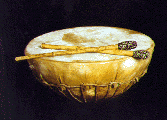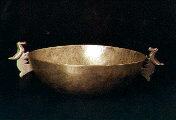 |
  |
|
In the ebbs and flows of a life in common, the mapuche interacts with the objects which he produces in constant proximity, centered on tasks which ensure that life is maintained or renewed (1). In this regard, his attitude and actions respond to his intimate link with nature. In a universe void of distance -which is not paraded before our senses like the articulated world of the West, that world which has been delivered to us from the moment that the Spaniards reached what they were to call America and of which the objects made by that civilization are a reflection-, the man of the earth lives his life primarily by applying knowledge and work. An avid observer, he clearly distinguishes the typical cycles of the seasons, reading the signs that will enable proper growth of the plants and animals that provide him with sustenance, controlling natural forces by physical and mental effort, expressed in work performed under the guidance of his knowledge, and by reflection, while at the same time heeding the legacy of his ancestors and of his community. However, he has learned that, in spite of his foresight and far beyond the scope of his efforts, there are agents and forces which may one year grant benefits of fertility without having been conquered by fatigue -his faith decrees that this is thanks to the designs of gods, such as Ngnechen owner of creation, who can ensure that everything works better and more easily, causing the sun, the rain, and so on, to appear at just the right moment-, but, in other years, these same agents bring bad luck and misfortune, persecute him from beginning to end, and hinder all his boldest efforts and most well-founded knowledge. In order to placate these influences, such as those of the weküfe, demons who make people ill, he indulges in rituals.
In all these operations whereby he seeks to be linked to and control the world, the objects that he produces as extensions of his system of beliefs emerge with evident supremacy of touch over sight, as can be observed, because of its very structure, in the elements that make up his ruka, house (2) , and in the furniture and utensils which it houses; it can be seen in the tranatrapihue, or mortar for grinding chilis, with those of stone being "massive, of variable shapes and generally crudely made, carved in blocks which sit naturally on a firm base and have an upper face that is suitable for excavating by the exertion of pressure and constant rubbing" (3) , in the ñillawaca, a recipient made of cow’s udder, in the witrü, a wooden spoon, or in the kullkull, a wind instrument made with a cow horn, in which a cut is made at one end to serve as a mouthpiece, and which is used for making calls, being primarily for social use. Touch prevails, as can also be seen in the instruments used in games, such as the palin or chueca. The object used in this game is called a weño, which is a stick whose thicker end is curved and which is used to hit a small ball; or in celebrations such as the machitun, the ceremony for healing, diagnosing, and/or treating a sick person, or in the nguillatun, a solemn community prayer made every so often, perhaps every two, or four, or six years, and in which steps are carved in the rewe, the trunk of a tree with the bark stripped off, which could be a laurel (Laurelia sempervirens), a maqui (Aristotelia chilensis), or a cinnamon tree (Drimys winteri chilensis) -their sacred tree-, which is then buried on top of a bed of silver coins as a type of symbol of a community or sector, and whose solid structure puts it in tune with benign forces.
Whether scarce or abundant, the material used for these objects, which are the result of deft technical operations imbued with a manual expression executed using rather rudimentary means (4), is molded by touch that is transposed visually in marks that are immediately palpable by simply contemplating the thing, as is the case of the pottery, where clay mixed originally with dust from the stone called ücu is transformed into metawe, jugs or pitchers for holding liquid, ketru metawe, a duck jug used for ritual purposes (5), challa or pots, etc., or of the textiles, where the wool from sheep previously spun with great care and, until a few decades ago, dyed wholly with herbs, such as relvún (Galium chilense), which resulted in a red color, or the hawthorn michay (Berberis linearifolia), which dyes a yellow color, is transformed into ponchos, woolen tunics, blankets, head and waist bands (trarilonko and trariwe), and whose traces of obvious "imperfections" reflect expressive signs of life, the life of the producer who, even though reiterating traditional forms (6), marks them with his own imprint. Thus, in every case, things (chemkün) are delivered to us in a depth that makes them seem enormous, stimulated by an expression which captures the strength of the material, to which the latter responds with measured rhythm. Here, the creating hand (7) -which in basketry produces the llepu, a recipient made from voqui fiber (Lardizabala biternata) and which is used to drain and serve grains, as well as the chünüwe, a sieve made of wood and leather with holes in it, or the sükill, a silver pectoral pendant- is not an instrument, but rather the extremity through which the force of nature is extended, and which causes the material to overflow in an expression that is fed by the deep-felt beats of the body. It so happens that, in the object which embodies their union, expression and material are exactly contemporaneous -a density that is confirmed by the plastic structure of the object-, and the articulations of the multiple parts that make it up evidence no demarcation, as is the case of the kultrung (8), a percussion instrument consisting of a wooden vessel covered with leather (goat, sheep, or horse), which fulfills several social functions. The most important is to serve the machi, a person chosen by a superior spirit to take charge of the physical, psychic, and social aspects of medicine ceremonies.
Thus, the construction of all objects seems to be rather more vegetable than vertebral, with each part opening up to its neighbor, and the objects surrendering themselves as a continuance of the surroundings-environment to which they belong, in a rhythm where they do not detach themselves from the world that surrounds them, but are rather its echo. Staying close to man, and showing neither fragility nor strength.
Lynda E. Avendaño Santana.
Teresa Canto Urra.
Bibliographical References Consulted:
- A.A.V.V., Responsability of: De Martino, Ernesto, Magia y Civilización, 1° edition, Milan-Italy, Edited by Garzanti, s.f.
- Bachelard, Gastón, La Poética del Espacio, 2° reprinting in Argentina, Buenos Aires-Argentina, Edited by Fondo de Cultura Económica, 1991.
- Coña, Pascual, Memorias de un Cacique Mapuche, 2° edition, Santiago-Chile, Edited by Icira-Instituto de Investigación en Reforma Agraria, April 1973.
- Dillehay, Tom D.; Gordon, Américo, "El Simbolismo en el Ornitomorfismo Mapuche. La Mujer Casada y el Ketru Metawe", in: Actas del VII Congreso de Arqueología, Santiago-Chile, Edited by Kultrung, 1977.
- Hernández S., Arturo; Ramos P., Nelly; Cárcamo Luna, Carlos, Diccionario Ilustrado. mapadungun, español, inglés, 1° edition, Santiago-Chile, Edited by Pehuen, August 1977.
- Joseph, H. Claude, La Vivienda Araucana, 1° edition, Santiago-Chile, Edited by Universidad de Chile, s.f.
- Moles, Abraham and others, Los Objetos. ("Colección Comunicaciones"), Buenos Aires-Argentina, Edited by Tiempo Contemporáneo S.A., 1971.
Sitio desarrollado por SISIB - Universidad de Chile